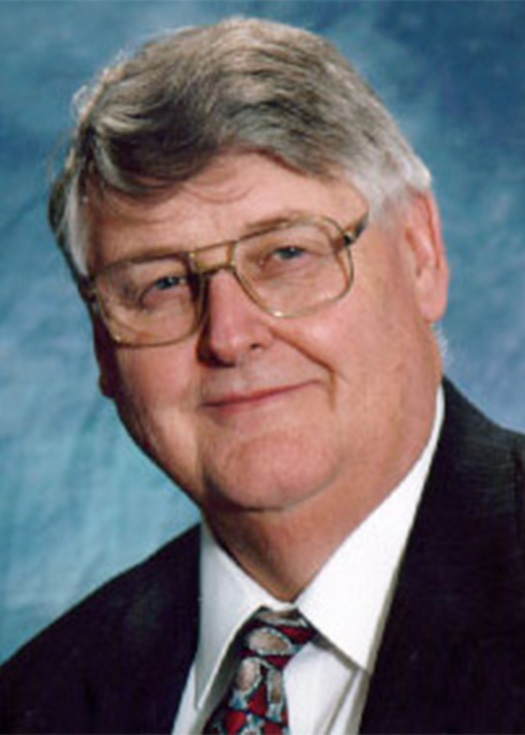In Memoriam: Charles (Charlie) Boyd Meinhold
1934-2017
bt Roger Cloutier

"The history of Charlie is like a history of health physics."
Charles Boyd Meinhold was born in Boston, Massachusetts, on 1 November 1934. After earning his BS in physics from Providence College (Providence, Rhode Island) in 1956, he received an Atomic Energy Commission (AEC) Fellowship to attend Rochester University and complete an internship at Brookhaven National Laboratory (BNL). In 1957, he joined the BNL staff, rising to serve as division head of the Safety and Environmental Protection Division from 1972 until 1988.
Friend and colleague Roger Cloutier remembers Charlie (as he was best known) in those early days:
It was just 10 years after the end of World War II and during the "Atoms for Peace" era when Charlie and I were both given AEC Fellowships to Rochester University. It was a small group in the health physics program. Charlie and I were good friends. Charlie liked to debate and debate we would when we ate lunch together. After a while, his position would start to change and so would mine. By the time we were done, we still had opposing positions, but they were opposite where we were when we started!
At the end of that program was the Health Physics Society [HPS] meeting in Pittsburgh. . . . Charlie and I went to the meeting as young scientists. They had a banquet there one evening and the Rochester group got a table way in the back—as far from the podium as possible. After the presentations started, a man entered and walked right over to us. He asked if he could sit down. After he did, some conversation started and turns out it was Harald Rossi, whose work on RBE [relative biological effectiveness] revolutionized dosimetry. Charlie was so excited about meeting him. He exclaimed "Oh, I can't believe it!" and shook Harald's hand. Afterward, Charlie said he would never wash his hand again. Later Charlie and I went to Brookhaven for a summer internship. Because Columbia University was one of the universities that managed the Brookhaven program, Charlie was able to work with Harald, which pleased Charlie greatly.
When Charlie started working at Brookhaven, his boss was Fred Cowan, who was the first president-elect of HPS in 1956. So Charlie was mentored into HPS that way. Fred was also involved with NCRP [National Council on Radiation Protection and Measurements] and that was how Charlie became involved, as well as eventually becoming the president of NCRP. Brookhaven was an exciting place to work. They had a cosmotron—probably the biggest accelerator in the world.
In 2000, Charlie retired from BNL after nearly 44 years there.
As his friend notes, Charlie was well known for his work for NCRP, whose website summarizes Charlie's many contributions. Charlie became a member of NCRP in 1978, served on the board of directors starting in 1980, and rose to become the third president of NCRP in 1991, a position he held until he retired from NCRP in 2002. He served on and chaired several NCRP scientific committees, was a member of the NCRP Nominating Committee, and organized many annual meeting programs.
But Charlie's influence in the radiation protection community extended beyond national boundaries. For the International Commission on Radiological Protection (ICRP), he served as chair of ICRP Committee 3 (1977–1985) and of ICRP Committee 2 (1985–1993). He served the International Radiation Protection Association (IRPA) first as a council member (1984–1988), then as vice president (1988–1992), and finally as IRPA president (1992–1996). From 1996 until 2009, Charlie was a member of the U.S. delegation to the United Nations Committee on the Effects of Atomic Radiation.
In the midst of his committee work, Charlie still made time to serve the HPS in many ways. For example, he was elected Society treasurer in 1975, and later he served two terms as a member of the Board of Directors. He was elected to the position of HPS president in 1981, in which he was followed the next year by his good friend Roger Cloutier. Roger recalls, "Charlie left a large footprint for me to follow as HPS president."
For his service, Charlie was named a fellow of the Health Physics Society, and in 2005, he was awarded the HPS Founders Award. He was certified by the American Board of Health Physics. In 1979, Charlie was invited by the Greater New York Chapter of HPS and the New York Radiological and Medical Physics Association to give the Failla Memorial Lecture. His lecture followed that of Nobel Laureate Rosalyn Yalow.
Charlie's many contributions to radiation protection were recognized internationally as well. Among other accolades, in 1994 Charlie received honorary awards from the China Institute of Atomic Energy, the China Institute of Radiation Protection, and the Medical College of Soochow (China) University. In 2001, Charlie traveled to Warsaw, Poland, to receive the Maria Sklodowska-Curie Medal for his outstanding contributions to the development of international radiation protection standards.
For all that he has done in a lifetime of service, Charlie will be sadly missed. He leaves behind his wife Anne, three daughters, two sons, and twelve grandchildren.
As his dear friend Roger Cloutier says, "The history of Charlie is like a history of health physics."
Written with thanks for assistance from Roger Cloutier, and NCRP, BNL, ICRP, and NCRP websites.



